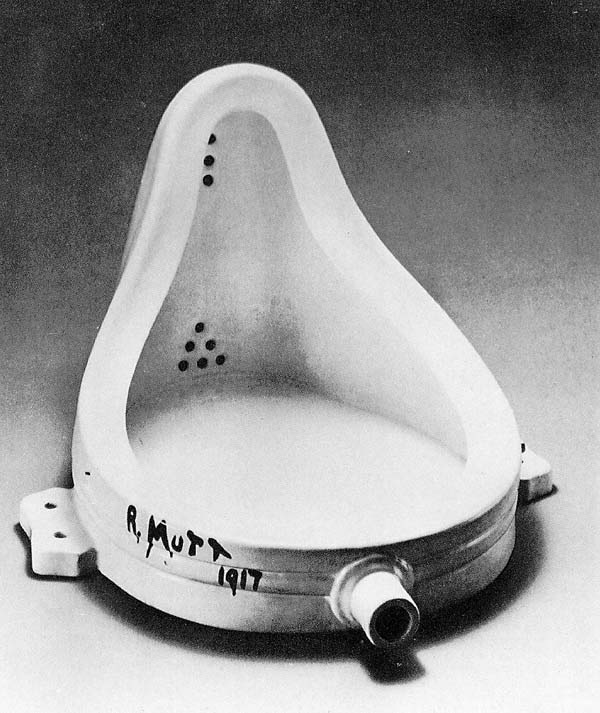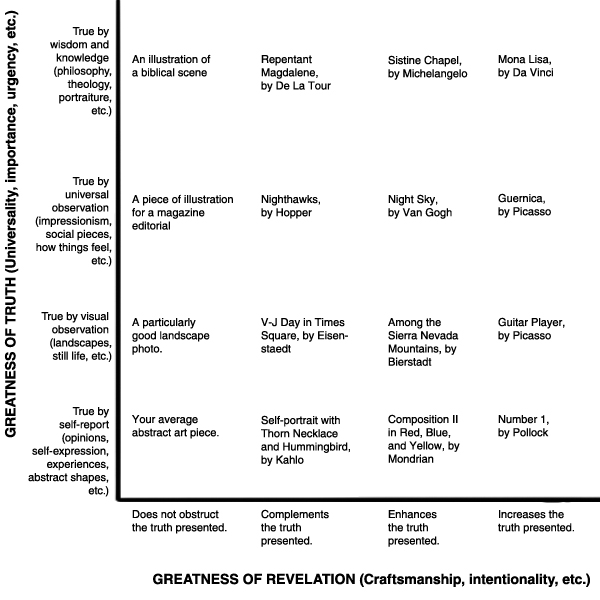
“But is it art?”
Now there’s a frustrating question. Yes! No! I have no idea! When’s lunch? As you walk through a gallery, the question, “What makes this art?” can suggest fifty answers, few of them particularly good.
Instead, let me suggest a more specific kind of question, which I think many people are trying to get at anyway. “Is this good art? Should I pay attention to this and take it seriously? How will I know great art when I see it?”
The best answer I have so far is this: “Art reveals truth. Great art reveals great truth in a great way.”
Admittedly, that’s a pretty broad definition… if asked, “What isn’t art?” I wouldn’t be able to give a long list of answers. I’d say that “not art” would be something which is not intended to reveal — like a tool built only to perform a task — or a thing which does not reveal truth — like pornography, which “reveals” a lie.
That leaves a whole lot in the “this is art” category… everything from Duchamp’s Fountain (pictured above) to Michelangelo’s Sistine Chapel. So are the Fountain and the Chapel on the same level?
Heck no.
This is where you get into what I consider to be the two meaningful questions about art:
- What kind of truth is it revealing?
A universal truth about the state of man? A truth about the beauty of creation? Truth about how the light hit a building at a certain time of day? Truth about how the artist feels about himself? - In what way is it revealing truth?
Is it presented as an epic? Quietly? With incredible detail and craftsmanship? Sloppily and hastily? Chaotically?
It’s in the relationship between the kind of truth being revealed and the way in which the revelation occurs that I really find the dialogue about art to be meaningful. Duchamp’s Fountain (above) reveals the ugly truth about the pretentiousness of art galleries in an ugly way. I would call that “ugly art,” but art, nonetheless, because it connects the message and the medium and actually reveals something true.
In fact, when I think about art, I usually have in mind some kind of grid like this:

(Note: I snapped this together really fast, so please don’t take offense if your favorite artist is in the wrong place.)
If we have some kind of interpretive framework like this, then instead of saying, “I like it!” or “I don’t get it,” or “Is it art?” we can start having meaningful conversations about the kind of truth being revealed, and the quality of the revelation.
What’s interesting about this framework is that, while it assumes an objective truth — that there is truth and that some truths are more important/universal than others — it also can be used to explain why different styles of art are valued more highly in various cultures; because what people perceive as the highest truth is pushed upwards towards the top of the grid.
Anyway, this is as far as I’ve gotten in evaluating art. I would greatly appreciate any comments; I’m assuming that I’ve missed crucial philosophical points, oversimplified badly, and ignored important arguments, so I need your help to broaden my horizons.
(Or, if this is actually helpful to you, I’d love to know that too.)
4 responses to “____ art reveals ____ truth in a ____ way.”
Well, here’s the thing… take Winnie the Pooh, or an abstract geometrical pattern, or Goodnight Moon, etc. Does it “reveal truth”? Not in any profound sort of way, no. Is it patterned, crafted, and excellent after its own kind? Yes, absolutely. It is art? I would say so.
I have a concern that either you will make the concept of “truth” so broad that it means ANY self-expression of the artist, in which case why are we bothering to talk about truth, or else on the other hand, if you keep the term “truth” meaningful, you will wind up excluding some of the simplest and most satisfying artistic works (i.e. Goodnight Moon), in which there is (I argue) artistry, but no Deeper Meaning.
P.S. I want your chart for my class. ;-) May I have a copy, please?
P.P.S. I love Brittainy’s definition of great art: “That which portrays the most meaningful things in the best ways.”
Really good point. I’d say that a geometrical pattern would be “true by self-report,” about the pleasingness of a pattern, but it would be “less great” art than, say a painting that pertains to the eternal state of mankind. Whereas a children’s book might be “greater” than the pattern because it has to do with revealing truths about innocence, imagination, etc. And assuming we’re talking about Escher and A.A. Milne here, both would be revealed in truly excellent ways, which would shove ’em to the right on the chart. (Still less “great” than Rembrandt, though.)
My basic suggestion is that much can be called art, but this gives a matrix for talking about what art is greater or lesser. And yes, those are fighting words, but it’s why it’s worth talking about.
Thoughts?
PS & PPS: You can have that copy! Although it’s very rough, just to give an idea. And I think I’m trying to say the same thing as Brittainy, roughly. Just maybe in a more categorized fashion.